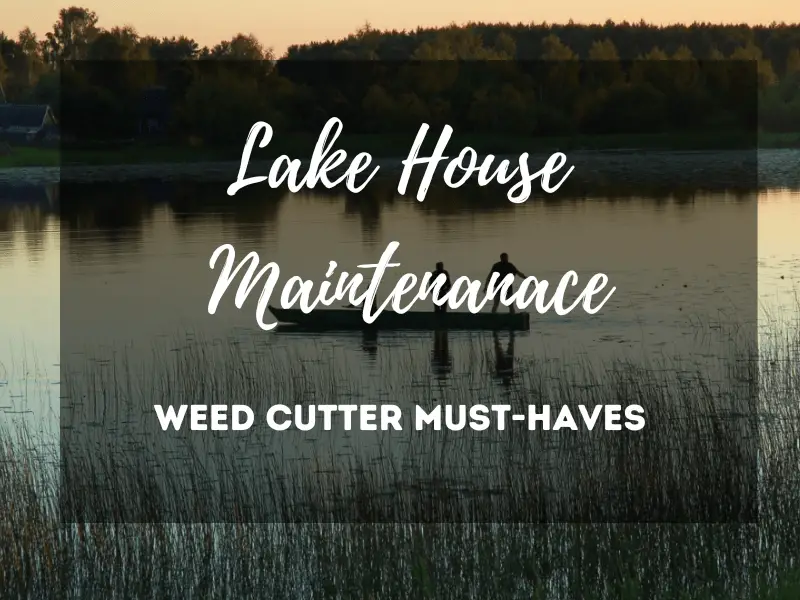
Lake House Maintenance: Weed Cutter Must-Haves
You might love the lake, but not the weeds. Excessive vegetation can spoil the enjoyment of the lake and make it difficult to swim and boat.
If there is an overgrowth of weeds and plants in the water by your shoreline, it puts quite a damper on the fun. The vegetation can become entangled in boat motors and make living on the lake hard to enjoy.
Table of Contents
Too Many Weeds Create Additional Problems
It is not just you that benefits from fewer weeds, the fish will thank you, too. Water that is clogged with weeds makes it harder for bigger fish to find food, and they can die out when weeds take over.
Excessive plant life also takes the oxygen out of the water, leaving it depleted of oxygen for aquatic life. Finding dead fish that wash ashore may be an indication that there is not enough oxygen in the water.
If dead fish and water that is difficult to get through weren’t enough, all that plant life in the water is the perfect breeding ground for mosquitoes. That alone is incentive enough to keep the weeds at bay.
Lake Weed Tools Are a Must-Have When Living On The Lake
There are several must-have tools that will help you in your efforts to keep your slice of the lake user-friendly. We have listed the four most popular ones below.
Check out some of our recommended tools here: Our Pick of the 7 Best Lake House Weed Cutters and then read on to find out how to use some of these tools.
Don’t miss the YouTube video at the end of the article where a lake dweller shows how to use these three of these tools and gives tips on making the process easier.

Lake Weed Rakes
Rather than using harsh and polluting chemicals in a lake, many lake homeowners will use alternate methods to control the weeds that can clog the areas near shore.
The must-have tool for this task is a weed rake. Designed to remove loose patches of both floating and rooted weeds, this is the most popular tool for the job.
An effective weed rake will be lightweight, as this minimizes leverage working against you as you reach into the water from the shore. Look for a rake that is long-handled with wide teeth that will drag a good amount of weeds with each stroke.
Some weed rakes are 40 inches in width, which brings in a wide swath of weeds but can also take a little muscle to handle.
Look for a weed rake that has a rope that attaches to the handle. That allows you to toss the rake into the water and then drag it back to shore.
A good weed rake will also have floatation attachments that enable the rake to glide on the surface of the water pulling weeds, rather than submerging in the silt below.
This YouTube video shows how a weed rake is used in a lake: Lake Weed Rake
Lake Weed Cutter
This tool is similar to a lake rake, as it is long-handled and lightweight. And although lightweight, a weed cutter is designed to sink to the bottom and cut the weeds in their path as you drag it back to shore.
Weed cutters have a unique V-shaped cutter head that has razor-sharp blades. These weed cutters’ blades are deadly sharp, so caution when using one is advised.
Keep your hands away from the blades and wear safety shoes when using a weed cutter. It is also a good idea to keep children away while this cutter is in use.
Most weed cutters will come with a blade sharpener. You will get the best results from a weed cutter by keeping the blades sharp. Keep the blade guards on the cutter when not in use.
The weed cutter will cut or shear the most rooted aquatic vegetation like watermilfoil, lily pads, pond weeds, and cattails.
When looking for a weed cutter, choose one that is light enough that you can toss it 25 or 30 feet, but heavy enough to sink straight to the bottom of the water.
After you have used a weed cutter, remove the cut plants with a weed rake as decaying vegetation can stimulate new vegetation.
Lake Muck Tiller
While dragging weeds from the lake with a weed rake takes care of the immediate problem, it is not a long-term solution. Lake weeds sprout from the bottom of the lake, so their root system remains intact when you rake the surface weeds out of the water.
A weed tiller has a rotating cylindrical head with hooked metal teeth that, as it is rolled along the lake bottom, digs through the mud and silt to pull out the root system.
The roots, once pulled out, float to the surface where you can get them out of the water with your weed rake.
Lake Hydro Sweep
Once you have gotten the weeds out of the area of the lake they were clogging, a hydro sweep can help keep the waters clear longer. Aeration and current are essential to a healthy waterfront and a hydro sweep provides both of these actions.
These devices improve water conditions naturally to help control algae and aquatic vegetation. The hydro sweep mimics the natural movement of lakes and allows you to control the direction of the 1400 gallons of water it pumps through its system every minute.
Designed to be mounted on a dock, a hydro sweep is effective up to 50 feet and has several useful benefits.
The sweep helps to rid the shoreline of stagnant water, keeping mosquitos down. The hydro sweep deters invasive species, reduces algae, and helps control decaying debris. You can also use the sweep to help control ice in the winter months.
There are several brands of hydro sweep on the market. Research which type of hydro sweep would be best for your lake, and check out the reviews that owners leave before purchasing one.
Final Thoughts
Lake living is a wonderful thing! Controlling the weeds and decaying plants around your lake shoreline and dock area will enable you to enjoy the water and boating without the nuisance that weeds bring.
The handy tools mentioned in this article should be must-haves for every lake homeowner.
Check out this YouTube video below. This lake homeowner shows you how to use three of the tools we mentioned to remove weeds from your lake:
Lake Weed Removal: How to get rid of lake weeds in 3 easy steps





